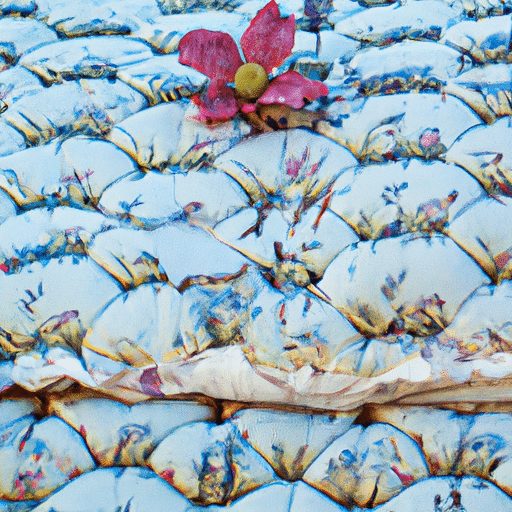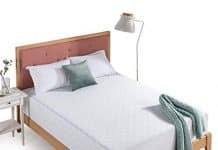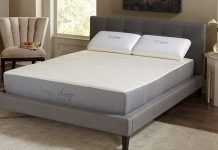If you’ve found yourself pondering this question, you’re not alone. We’ve all been there, tossing and turning on a worn-out mattress that just doesn’t provide the comfort it once did. But fear not, because today we’re here to share some simple yet effective ways to bring new life to your old mattress. From flipping and rotating to investing in a mattress topper, we’ve got you covered. So say goodbye to sleepless nights and hello to a rejuvenated slumber experience!
Review contents
Cleaning the Mattress
Remove Bedding and Vacuum
To start the process of reviving an old mattress, the first step is to remove all bedding, including sheets, pillowcases, and any mattress protectors. This will allow you to have a clear and clean surface to work with. Once the bedding is removed, it’s time to grab your vacuum cleaner. Use the upholstery attachment and gently vacuum the entire surface of the mattress. This will help remove any surface debris, dust, and allergens that may have accumulated over time.
Treat Stains and Odors
After vacuuming, it’s important to address any stains or lingering odors on the mattress. Stains can be treated using a mixture of mild detergent and water. Apply the solution to the stained area and gently blot with a clean cloth. Avoid saturating the mattress as this can lead to mold or mildew growth. For stubborn stains, you can also try using a specialized stain remover designed for mattresses.
To eliminate odors, sprinkle baking soda generously over the entire surface of the mattress. Let it sit for a few hours or overnight to allow the baking soda to absorb any unpleasant odors. Then, use the vacuum cleaner once again to remove the baking soda residue.
Deodorize the Mattress
Once the stains and odors have been tackled, it’s time to deodorize the mattress further. You can do this by creating a simple homemade mattress deodorizer. Mix equal parts of baking soda and cornstarch in a bowl, and then add a few drops of your favorite essential oil for a pleasant scent. Sprinkle the mixture over the mattress, focusing on areas that may have trapped odors, such as the corners and seams. Leave it for a few hours, and then thoroughly vacuum the mattress once again to remove the deodorizing mixture.
Flipping and Rotating
Flipping the Mattress
Flipping your mattress is an effective way to revive an old mattress and ensure even wear. Most traditional mattresses are two-sided, which means they can be flipped regularly to distribute the weight and pressure evenly. Start by removing all bedding and carefully flip the mattress over. This will provide a fresh side to sleep on and help prevent sagging and uneven wear.
Rotating the Mattress
In addition to flipping the mattress, it is also beneficial to rotate it periodically. This means turning the mattress 180 degrees, so the foot of the bed becomes the head. By rotating the mattress, you can prevent certain areas from becoming worn down excessively, leading to a more even distribution of weight and extended mattress lifespan.
Using Mattress Toppers
Memory Foam Mattress Topper
A memory foam mattress topper can be a game-changer when it comes to reviving an old mattress. These toppers are made from high-density foam that molds to the shape of your body, providing excellent support and comfort. Simply place the memory foam topper on top of your mattress, and you’ll immediately notice an improvement in cushioning and pressure relief.
Latex Mattress Topper
For those seeking a more eco-friendly option, a latex mattress topper is an excellent choice. Latex is derived from rubber tree sap and offers natural breathability and durability. It provides a supportive yet responsive surface that can instantly revive an old mattress. Latex toppers are also resistant to dust mites and mold, making them a great option for allergy sufferers.
Fiberfill Mattress Topper
If you’re looking for a budget-friendly option, a fiberfill mattress topper can be an ideal solution. These toppers are filled with synthetic fibers, such as polyester, and offer a plush and soft surface. While they may not provide the same level of support as memory foam or latex, they can still make a noticeable difference in comfort for an old mattress.
Implementing Proper Bedding
Quality Mattress Protector
To preserve the lifespan of your newly revived mattress, it’s crucial to invest in a quality mattress protector. A mattress protector acts as a barrier, protecting your mattress from spills, stains, and allergens. Look for a waterproof and breathable protector that is easy to clean and fits securely around your mattress. By using a mattress protector, you’ll not only ensure the cleanliness of your mattress but also enhance its overall longevity.
Fitted Sheet and Bedding Layers
Choosing the right fitted sheet and bedding layers can significantly impact your comfort level when reviving an old mattress. Opt for a fitted sheet with deep pockets that securely fits around your mattress without slipping off. Additionally, consider using multiple layers of bedding, such as a mattress topper, a fitted sheet, a mattress pad, and a top sheet. This layering technique adds extra cushioning and support while also creating a more luxurious and cozy sleeping environment.
Repairing Sagging Areas
Using Mattress Pads
If you’ve noticed sagging or uneven areas on your old mattress, using a mattress pad can provide temporary relief and support. Mattress pads are generally made of foam or fiberfill and can be placed directly on top of your mattress. They help fill in gaps and provide extra cushioning to make your sleep surface more comfortable. While mattress pads are not a permanent fix for a sagging mattress, they can buy you some time until a more comprehensive solution is implemented.
Supporting the Mattress with Plywood
For mattresses with severe sagging issues, supporting the mattress with plywood can be an effective solution. Start by removing the mattress from the bed frame and placing a sturdy piece of plywood between the mattress and the frame. Make sure the plywood is cut to the exact size of the mattress and evenly supports the entire surface. This simple fix helps provide additional support and prevents further sinking in the sagging areas.
Replacing or Reinforcing Springs
If your old mattress has coil springs and they are causing discomfort or sagging, it may be necessary to replace or reinforce them. This is a more advanced solution that may require professional assistance, especially if you’re unfamiliar with the inner workings of a mattress. Consider consulting a mattress technician or a reputable mattress retailer to assess the condition of the springs and determine the best course of action.
Enhancing Comfort with Pillows
Choosing the Right Pillow
Pillows play a vital role in ensuring a comfortable and supportive sleeping environment. When selecting a pillow for your revived mattress, consider your sleeping position and personal preferences. Side sleepers typically benefit from a firm and supportive pillow that maintains proper spinal alignment. Back sleepers may prefer a medium-firm pillow that cradles the neck and head. Stomach sleepers should look for a soft and low-profile pillow to prevent strain on the neck.
Stacking Pillows for Support
If you’re still experiencing discomfort or lack of support even after reviving your old mattress, stacking pillows can be an effective solution. Layering different types of pillows can help customize your sleeping surface and provide the desired support for your specific needs. For example, you can place a firm pillow beneath a softer one to create a more supportive and comfortable sleeping position.
Pillow Placement
In addition to choosing the right pillows and stacking them strategically, proper pillow placement can also make a difference in your comfort level. When sleeping on your side, place the pillow between your knees to alleviate pressure on the hips and lower back. Back sleepers can benefit from placing a pillow under their knees to support the natural curve of the spine. Stomach sleepers should consider using a thin pillow or no pillow at all to maintain proper alignment.
Regulating Temperature
Using Breathable Fabrics
Temperature regulation is essential for a comfortable sleep environment. When reviving an old mattress, consider using bedding and fabrics that are breathable and moisture-wicking. Natural fibers such as cotton and bamboo are excellent choices as they promote airflow and help dissipate body heat, keeping you cool throughout the night. Avoid synthetic materials that tend to trap heat and moisture, leading to discomfort and potential sleep disturbances.
Utilizing Cooling Mattress Toppers or Pads
For individuals who struggle with sleeping hot, utilizing cooling mattress toppers or pads can greatly improve comfort. These products are designed to regulate temperature and provide a cooling effect. Cooling mattress toppers are often infused with gel or have a ventilated design to enhance airflow. Cooling mattress pads, on the other hand, can be placed directly on top of the mattress and offer a refreshing and cool sleep surface.
Adjusting Room Temperature
Another way to regulate temperature and ensure a comfortable sleep experience is by adjusting the room temperature. Keep your bedroom cool, ideally between 60-67 degrees Fahrenheit, as this range is considered optimal for sleep. Additionally, using a fan or an air conditioner can help circulate air and maintain a cooler temperature. Experiment with different room temperatures to find what works best for you and promotes restful sleep.
Addressing Allergies and Dust
Vacuuming Regularly
Allergens and dust can accumulate quickly on a mattress, aggravating allergies and affecting sleep quality. To minimize allergens, it’s important to vacuum your mattress regularly. Use the upholstery attachment on your vacuum cleaner and make sure to cover the entire surface of the mattress, paying extra attention to seams, corners, and crevices. This will help remove dust mites, dead skin cells, and other allergens, resulting in a cleaner and healthier sleep environment.
Using Allergy-Proof Mattress Covers
Investing in allergy-proof mattress covers can provide an additional layer of protection against dust mites, pet dander, and other allergens. These covers create a barrier between you and your mattress, preventing allergens from seeping into the fabric and triggering allergic reactions. Look for hypoallergenic and breathable covers that are easy to clean and maintain.
Washing Bedding Frequently
Regularly washing your bedding, including sheets, pillowcases, and blankets, is crucial in maintaining a clean and allergen-free sleep environment. Bedding should be washed at least once a week, using hot water to kill dust mites and eliminate any accumulated allergens. Additionally, make sure to dry bedding thoroughly to prevent the growth of mold or mildew.
Air Purifiers and Humidifiers
For individuals with severe allergies or respiratory conditions, using air purifiers and humidifiers in the bedroom can significantly improve sleep quality. Air purifiers help filter out allergens and pollutants from the air, while humidifiers add moisture to alleviate dryness and irritation. These devices work together to create a clean and comfortable sleep environment, reducing the chances of allergies and promoting better overall health.
Considering Professional Services
Mattress Cleaning Services
If your efforts to revive your old mattress seem insufficient or you prefer professional assistance, consider hiring a mattress cleaning service. These services utilize specialized equipment and cleaning solutions to deep clean and sanitize your mattress, removing stubborn stains, odors, and allergens. Professional cleaning can restore the freshness and extend the lifespan of your mattress, ensuring a healthier and more comfortable sleep surface.
Mattress Refurbishing or Reconditioning
In some cases, an old mattress may require more than just routine cleaning and maintenance. If your mattress is severely worn, sagging, or has visible structural issues, it may be worth considering professional refurbishing or reconditioning services. These services involve repairing or replacing damaged components, reinforcing sagging areas, and restoring the mattress to its original state. While refurbishing can be more expensive than cleaning, it can significantly extend the lifespan of your mattress and improve overall comfort and support.
Mattress Recycling or Donation
If your old mattress is beyond repair or you’re simply ready for an upgrade, it’s important to consider responsible disposal options. Mattresses are not recyclable with regular household waste, so researching local mattress recycling facilities or donation centers is a worthwhile endeavor. Recycling mattresses helps reduce environmental impact by diverting them from landfills and ensuring that the materials are properly recycled or repurposed. Donating mattresses to charitable organizations is another great option as it allows others in need to benefit from your well-loved but still usable mattress.
Knowing When to Replace
Monitoring Comfort and Support
While reviving an old mattress can provide temporary relief, it’s essential to monitor its comfort and support levels over time. If you find yourself consistently waking up with aches, pains, or discomfort, it may be a sign that your mattress no longer provides adequate support. Listen to your body and pay attention to these signals, as they can indicate the need for a replacement.
Checking for Visible Wear and Tear
Inspect your mattress regularly for any visible signs of wear and tear. Look out for sagging, lumps, or visible indentations, as these are indicators of structural damage. Additionally, check for loose or broken springs, frayed edges, or ripped fabric. If these issues are present and cannot be repaired, it’s likely time to start considering a new mattress.
Assessing the Age of the Mattress
The age of your mattress is also a crucial factor to consider when determining whether it’s time for a replacement. On average, most mattresses have a lifespan of about 7-10 years. However, this can vary depending on the quality of the mattress, usage, and individual preferences. If you’ve had your mattress for a significant amount of time and have exhausted all methods of reviving it, it might be worth considering investing in a new one to ensure optimal comfort and support for a good night’s sleep.
Reviving an old mattress is not an impossible task. By following these comprehensive steps and considering the various methods mentioned, you can breathe new life into your old mattress and improve your sleep quality. Remember to regularly maintain and clean your mattress, incorporate quality bedding, and address any specific issues like sagging or discomfort. And when the time comes, don’t hesitate to replace your mattress to ensure you’re getting the restful sleep you deserve.































